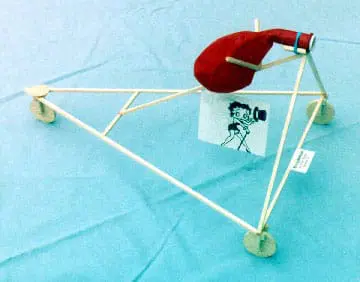Boopmobile

| Race Order |
Entry # |
Driver Name | Car Name | Mass (grams) |
Length (inches) |
Width (inches) |
Height (inches) |
Distance Traveled (feet) |
Running Time (seconds) |
Awards |
| 5 | 34 | Paul Richter | Boopmobile | 10 | 12 | 9 | 6.75 | 28.75 | 20.19 | Lightest |
Balloon car designer Paul H. Richter, JPL Section 331, writes:
I want to begin by saying that participating in the contest was for me
immensely rewarding. The contest itself was a blast (no pun intended),
and the learning experience involved in the design and construction of
my entry provided many hours of enjoyment – and naturally, not a little frustration.I began by studying some fluid dynamics in order to better understand the
limitations imposed by the balloon itself, considered as a pure rocket.
To this end I dusted off my copy of Sommerfeld’s marvelous treatise,
The Mechanics of Deformable Bodies, one of the most beautifully written
texts on physics ever published, replete with detailed descriptions of
such things as Reynolds’s elegant experiments on laminar and turbulent flow,
for example.It soon became clear that the most efficient use of the elastic energy
stored in the balloon, aside from the obvious one of using it as a rubber
band, was an air motor of some sort, since the exhausting air from the
balloon used as a rocket necessarily carries off most of the energy as
it deflates. However, I could not think of a simple, workable scheme
for building such a motor with the time and resources available, and
hence decided to try to maximize the performance of the pure rocket design.I confess that this decision was to some extent influenced by the Laboratory’s name.
At this point I began to gather data on the characteristics of the balloon
(pressure vs volume diagrams, for example) and the performance of different
nozzle designs, the latter being accomplished through the construction of
a simple but effective test stand consisting of a 1/2 inch x 12 inch thin
walled brass tube suspended from the ceiling by two threads, forming a
simple pendulum. The balloon under test was secured to one end of the
tube, and the nozzle to the other, and the displacement measured as the
balloon deflated, thus permitting a determination of the thrust of the
assembly as a function of time.All of these measurements were made in the kitchen, so that the place
soon took on the appearance of a do-it-yourself physics lab.Using these data, I ran computer simulations at home of runs of a rocket
car under varying assumptions of drag, friction, weight, etc., in order to
determine the optimum design parameters, and finally settled on a light weight,
balsa frame tricycle using a single balloon. The nozzle was fabricated by
forming a 1/2 inch x 1 inch tube of paper around two 1/2 inch by 1 mm thick
balsa discs at either end, with the nozzle itself consisting of a 1 inch length
of small bore glass tubing inserted in holes previously cut in the balsa discs.
Three such nozzle assemblies of different bore were made and tested in the car,
and good agreement was found with the computer simulations.The wheels were fabricated by hand from 1/8 inch thick balsa stock, and used
small diameter brass tubing bearings running on closely matched piano wire axles
for low friction. The front wheel was made steerable by means of a simple vertical
dowel turning under moderate friction in a balsa housing, thus permitting manual
adjustment for optimal steering for a given course. The overall coefficient of
friction for the car, including rolling friction and bearing friction, was found
to be 0.02, which I consider quite good.When tested on the sidewalk in front of my house on the morning of the contest,
the car traveled 55 ft, whereas at the contest it traveled only about 29 ft.
Maybe I was a little nervous, and didn’t blow the balloon up enough, or maybe
there was a slight head wind, or maybe the JPL course is slightly uphill,
or maybe —?As for lessons learned, adding a second balloon would have been relatively
easy, but the thing that intrigues me the most is achieving laminar flow in
the rocket nozzle. My present designs all employ turbulent flow, and there
is a considerable gain in performance to be had by reducing the nozzle
pressure drop through the utilization of laminar flow, and I think I now
know how to achieve this.
MB 1/9/99
